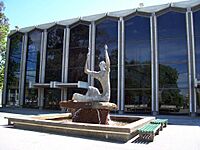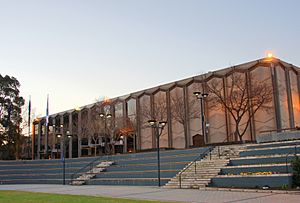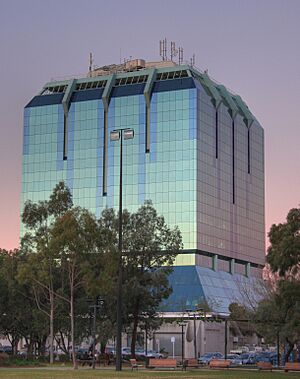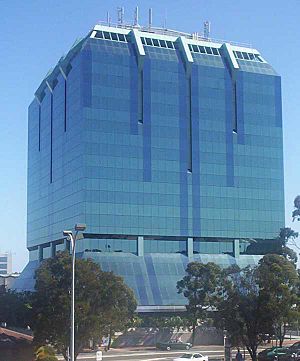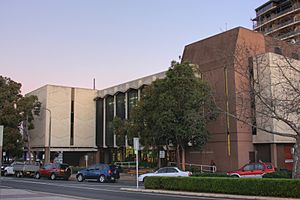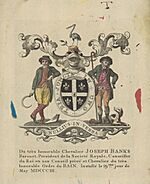City of Bankstown facts for kids
Quick facts for kids City of BankstownNew South Wales |
|||||||||||||||
|---|---|---|---|---|---|---|---|---|---|---|---|---|---|---|---|

Location in Metropolitan Sydney
|
|||||||||||||||
| Population | 193,398 (2011 census) (15th) | ||||||||||||||
| • Density | 2,374/km2 (6,150/sq mi) | ||||||||||||||
| Established | 7 September 1895 | ||||||||||||||
| Abolished | 12 May 2016 | ||||||||||||||
| Area | 76.8 km2 (29.7 sq mi) | ||||||||||||||
| Time zone | AEST (UTC+10) | ||||||||||||||
| • Summer (DST) | AEDT (UTC+11) | ||||||||||||||
| Mayor | Khal Asfour | ||||||||||||||
| Council seat | Bankstown | ||||||||||||||
| Region | Inner West | ||||||||||||||
 |
|||||||||||||||
| Website | City of Bankstown | ||||||||||||||
|
|||||||||||||||
The City of Bankstown was a local government area in the south-west region of Sydney, Australia, centred on the suburb of Bankstown, from 1895 to 2016. The last mayor of the City of Bankstown Council was Clr Khal Asfour, a member of the Labor Party.
A 2015 review of local government boundaries by the NSW Government Independent Pricing and Regulatory Tribunal recommended that the City of Bankstown merge with the City of Canterbury to form a new council with an area of 110 square kilometres (42 sq mi) and support a population of approximately 351,000. On 12 May 2016, the NSW Government announced that Bankstown would merge with the City of Canterbury to be known as the City of Canterbury-Bankstown.
Contents
Suburbs of the City of Bankstown
Suburbs and localities in the former local government area were:
|
|
- Notes
History
District of Bankstown was named by Governor Hunter in 1797 in honour of botanist Sir Joseph Banks, who travelled to Australia with Captain James Cook in 1770. The area was discovered during an expedition of the Georges River by George Bass and Matthew Flinders. The area of first European settlement along the river has been partially preserved as part of the Mirrumbeena Regional Reserve. Bankstown also includes large areas of the Georges River National Park. Railway formed an important part of the development of Bankstown. After the extension of the railway from Belmore to Bankstown in the 1890s, rapid development of the area followed – so much so that the commercial centre of Bankstown moved from its former position in Irish Town (Now Yagoona) on Liverpool Road to the vicinity of Bankstown railway station.
In March 1895 a petition was submitted to the NSW Colonial Government by 109 residents of the Bankstown area, requesting the establishment of the "Municipal District of Bankstown" under the Municipalities Act, 1867. The petition was subsequently accepted and the Municipal District of Bankstown was proclaimed by Lieutenant Governor Sir Frederick Darley on 7 September 1895. The first six-member council, standing in one at-large constituency, was elected on 4 November 1895. With the passing of the Local Government Act 1906, the council area became known as the Municipality of Bankstown.
Bankstown's city status was proclaimed in 1980 in the presence of Queen Elizabeth II, becoming the "City of Bankstown". On 12 May 2016, the City of Bankstown was merged with the City of Canterbury to form the Canterbury-Bankstown Council.
World War II
The Bankstown Bunker was an exact replica of the underground Ops rooms of wartime England, which directed Britain's air defence fighter plane attacks on the invading German Luftwaffe. Entrance to the bunker was obtained through a concrete passageway which was well screened by a grassy slope; a stairway led to a virtual maze of corridors and hallways leading to various sections. There were two points into to the bunker (escape hatches) which were guarded by military police, and access was gained via the bottom level.
The walls of the bunker could almost withstand a direct hit from a 300 pounds (140 kg) bomb.
Council seats
Council Chambers (1918)
On 29 June 1918 the new Council Chambers building located on South Terrace south of the Bankstown railway station (now No. 9 Bankstown City Plaza) was officially opened by the mayor, A. Townsend. Completed to a cost of £4,000, the new Council Chambers building was designed by prominent architect and mayor of Kogarah, Charles Herbert Halstead, and built by A. G. Swane. At the time of opening the street frontage included a post office, and a branch of the Australian Bank of Commerce. This remained the Council's primary meeting place and offices until new offices in the Civic Centre to the north were completed in 1963.
Civic Centre and Council Chambers (1963)
By the early 1960s, Bankstown Council sought a new headquarters that would be able to accommodate a growing organisation as well as provide a new 'civic centre' for the Council area. In 1961, the council commissioned a modernist design by architect Kevin Curtin, which envisaged a complex of an Administration Building, a Council Chamber roundhouse, and a Town Hall with the capacity for 1,500 people, to be located on a large block north of the Bankstown railway station between Chapel Road, Rickard Road, Appian Way and The Mall. The Council Chambers was the first building completed and took the form of a roundhouse and was built by Monier Builders Pty Ltd, with the interior fittings and furniture designed by Maison Paul Pty Ltd of Greenacre, featuring timberwork in Queensland walnut timber (Endiandra palmerstonii). The consulting engineers for the project were M. G. Bull (structural) and John R. Wallis, Spratt & Associates (electrical and mechanical).
Administration building
The administration building was officially opened on 2 December 1963. It was built to house the majority of council's staff and departments, and was a two-storey square block with an external colonnade and basement level for parking. The rates, health & building, and Town Clerk's departments were located on the ground floor, while the upper floor contained the engineering and planning departments. The building's main lobby featured a mosaic mural by Michael Santry depicting the history of Bankstown, in addition to marble-clad columns, timber panelling, and terrazzo floors. In 1964, the exterior lighting of the Civic Centre received an award for meritorious lighting from the Australian Illuminating Engineering Society. In 1966 a new fountain, the "Dane Fountain", was unveiled outside the building to commemorate the service of H. W. Dane as administrator of the council.
On Tuesday 1 July 1997, a fire in the building, caused by a spark from maintenance works to bring the building up to modern standards, resulted in the complete destruction of the Administration Building, along with a large number of council records and historical items. With the Council offices relocated to the nearby Bankstown Civic Tower, the remains of the Administration Building were cleared and its site became the location for a new central park which was officially named Paul Keating Park on 13 June 2000.
Spirit of Botany
In 1963, as part of the works to complete the new Bankstown Civic Centre, the council commissioned sculptor Alan Ingham to create a memorial statue to Sir Joseph Banks. Ingham accepted on the basis that he would create a statue that would be to the 'spirit of botany', a more abstract representation of Banks' work in the field, that would blend with the modernist style of the new Civic Centre: "It would be controversial and create far more interest than a statue of the man". The cast aluminium statue was officially unveiled on 7 April 1964 atop a base of rocks. When the Town Hall was completed in 1973, the statue was moved to the Town Hall forecourt as part of a fountain. In 2012 as part of the Bankstown Library and Knowledge Centre project the statue was moved again to a more prominent location further south at the south-western corner of Paul Keating Park.
Town hall
The final element of the Civic Centre to be completed was the town hall, designed as a theatre for 1,500 people, at the north-western end of the site. It was officially opened on 30 June 1973 by Prime Minister Gough Whitlam. The Town Hall project was overseen by Civil and Civic (a Lendlease subsidiary). In 2013, the Town Hall was upgraded and redeveloped as part of the Bankstown Library and Knowledge Centre project to become a 300-seat theatre named the "Bryan Brown Theatre", with the eastern side demolished and replaced by a new Library and "Knowledge Centre".
Civic Tower
In 1989, Council commissioned a new 14-storey "Civic Tower" office building at 66-72 Rickard Road to accommodate additional council staff, state government agencies, and rented office space. With construction beginning in 1990, the tower was complete by 1991. The Civic Tower became the primary Council offices from 1997 to 1999 following the destruction of the Administration Building.
Demographics
At the 2011 Census, there were 182,352 people in the Bankstown local government area, of these 49.3% were male and 50.7% were female. Aboriginal and Torres Strait Islander people made up 0.8% of the population. The median age of people in the City of Bankstown was 35 years, which is slightly lower than the national median of 37 years. Children aged 0 – 14 years made up 21.7% of the population and people aged 65 years and over made up 13.7% of the population. Of people in the area aged 15 years and over, 52.1% were married and 11.0% were either divorced or separated.
Population growth in the City of Bankstown between the 2001 Census and the 2006 Census was 3.43%; and in the subsequent five years to the 2011 Census, population growth was 6.96%. When compared with total population growth of Australia for the same periods, being 5.78% and 8.32% respectively, population growth in Bankstown local government area was approximately 75% of the national average. The median weekly income for residents within the City of Bankstown was slightly lower than the national average.
At the 2011 Census, the proportion of residents in the Bankstown local government area who stated their ancestry as Lebanese, was in excess of eight times the national average. The proportion of residents who stated an affiliation with Islam was in excess of eleven times the national average. Meanwhile, as at the Census date, the area was linguistically diverse, with Arabic or Vietnamese languages spoken in 30% of households, both languages approximately seven times the national averages.
| Selected historical census data for Bankstown local government area | |||||
|---|---|---|---|---|---|
| Census year | 2001 | 2006 | 2011 | ||
| Population | Estimated residents on Census night | 164,841 | 170,489 | 182,352 | |
| LGA rank in terms of size within New South Wales | 6th | ||||
| % of New South Wales population | 2.64% | ||||
| % of Australian population | 0.88% | ||||
| Cultural and language diversity | |||||
| Ancestry, top responses |
Australian | 15.2% | |||
| Lebanese | 14.9% | ||||
| English | 12.5% | ||||
| Vietnamese | 7.2% | ||||
| Chinese | 6.3% | ||||
| Language, top responses (other than English) |
Arabic | 13.6% | |||
| Vietnamese | 7.2% | ||||
| Greek | 4.1% | ||||
| Cantonese | 3.0% | ||||
| Mandarin | n/c | ||||
| Religious affiliation | |||||
| Religious affiliation, top responses |
Catholic | 31.1% | |||
| Islam | 11.9% | ||||
| Anglican | 15.5% | ||||
| Eastern Orthodox | 8.7% | ||||
| No Religion | 6.3% | ||||
| Median weekly incomes | |||||
| Personal income | Median weekly personal income | A$372 | A$428 | ||
| % of Australian median income | 79.8% | 74.2% | |||
| Family income | Median weekly family income | A$926 | A$1,228 | ||
| % of Australian median income | 90.2% | 82.9% | |||
| Household income | Median weekly household income | A$1,069 | A$1,091 | ||
| % of Australian median income | 91.3% | 88.4% | |||
Council
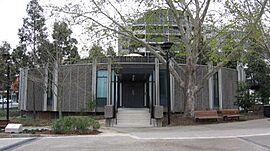
Final composition and election method
Bankstown City Council was composed of twelve councillors elected proportionally as four separate wards, each electing three councillors. All councillors were elected for a fixed four-year term of office. The mayor was elected by the councillors at the first meeting of the council. The most recent and last election was held on 8 September 2012, and the makeup of the council prior to its abolition was as follows:
| Ward | Councillor | Party | Notes | |
|---|---|---|---|---|
| East Ward | Khal Asfour | Labor | Mayor 2011–2014, 2015–2016 Deputy Mayor 2008–2011. | |
| Naji Najjar | Liberal | |||
| Dan Nguyen | Labor | Deputy Mayor 2015–2016. | ||
| North Ward | Alex Kuskoff | Labor | ||
| Michael Tadros | Liberal | |||
| Jenny Golledge | Labor | |||
| South Ward | Jim Daniel | Liberal | ||
| Linda Downey | Labor | Mayor 2014–2015. | ||
| Scott Parker | Independent | Deputy Mayor 2012–2014. | ||
| West Ward | Glen Waud | Liberal | ||
| Ian Stromborg | Labor | |||
| Allan Winterbottom | Labor | Deputy Mayor 2011–2012, 2014–2015. | ||
Mayors and General Managers
Mayors
| # | Mayor | Party | Term | Notes | |
|---|---|---|---|---|---|
| 1 | Joseph James Cooper | Independent | 7 November 1895 – 11 June 1896 | ||
| 2 | Ines Peter Miller | Independent | 11 June 1896 – 16 February 1899 | ||
| 3 | Nicholas Goyen, Jnr | Independent | 16 February 1899 – 15 February 1900 | ||
| 4 | William Gilliver | Independent | 15 February 1900 – 12 February 1903 | ||
| 5 | Arthur Bransgrove | Independent | 12 February 1903 – 16 February 1905 | ||
| 6 | William John Gibson | Independent | 16 February 1905 – 1 March 1908 | ||
| 7 | William Henry Watson | Independent | 1 March 1908 – 28 February 1909 | ||
| – | William Gilliver | Independent | 1 March 1909 – 28 February 1911 | ||
| – | Arthur Bransgrove | Independent | 1 March 1911 – 28 February 1913 | ||
| 8 | Frederick George White | Independent | 1 March 1913 – August 1913 | ||
| 9 | John Arthur Hoskins | Independent | August 1913 – 8 February 1915 | ||
| – | William John Gibson | Independent | 8 February 1915 – July 1917 | ||
| 10 | Alfred Townsend | Independent | July 1917 – 1917 | ||
| 11 | James Hunter Lee | Labor | 1917 – February 1918 | ||
| – | Alfred Townsend | Independent | February 1918 – 4 February 1919 | ||
| 12 | Cornelius Manahan | Labor | 4 February 1919 – February 1920 | ||
| 13 | John George Graf | February 1920 – 7 December 1920 | |||
| 14 | David Kennedy | 7 December 1920 – 6 December 1921 | |||
| 15 | John Jensen | 6 December 1921 – 5 December 1922 | |||
| – | David Kennedy | 5 December 1922 – December 1923 | |||
| 16 | Percy James George Coleman | December 1923 – December 1924 | |||
| 17 | Charles Edward Hercules Griffiths | Independent | December 1924 – December 1925 | ||
| 18 | Michael Joseph Fitzpatrick | Independent | December 1925 – December 1926 | ||
| 19 | Patrick John O'Neill | Labor | December 1926 – December 1927 | ||
| 20 | William Mannell | December 1927 – December 1928 | |||
| 21 | Charles Arthur Welch | Independent | December 1928 – 3 December 1929 | ||
| 22 | Patrick Clancy | Labor | 3 December 1929 – 8 December 1930 | ||
| – | Michael Joseph Fitzpatrick | Independent | 8 December 1930 – 7 January 1932 | ||
| – | Charles Edward Hercules Griffiths | Independent | 7 January 1932 – 5 December 1932 | ||
| 23 | James Cragg | Independent | 5 December 1932 – 4 December 1933 | ||
| – | Charles Edward Hercules Griffiths | Independent | 4 December 1933 – 13 December 1933 | ||
| – | William Robert Wylie (Administrator) | 13 December 1933 – 1 December 1934 | |||
| – | James Cragg | Reform | 3 December 1934 – 2 December 1935 | ||
| 24 | James Gosling | 2 December 1935 – 13 December 1937 | |||
| – | Percy James George Coleman | Labor | 13 December 1937 – 11 December 1939 | ||
| 25 | Thomas James Stevens | 11 December 1939 – December 1940 | |||
| – | Charles Edward Hercules Griffiths | Independent | December 1940 – December 1941 | ||
| 26 | A. H. Middleton | Independent | December 1941 – 24 December 1942 | ||
| 27 | William Flood | Labor | 24 December 1942 – 9 December 1943 | ||
| 28 | Stephen Everard Roberts | Independent | 9 December 1943 – December 1944 | ||
| – | Percy James George Coleman | Labor | December 1944 – 12 December 1946 | ||
| 29 | Clarence Williams | Independent | 12 December 1946 – 4 December 1947 | ||
| 30 | Arthur Henry Smith | Independent | 4 December 1947 – December 1949 | ||
| 31 | Alfred James Johnston | Independent | December 1949 – 7 December 1950 | ||
| 32 | Blanche Barkl | Independent | 7 December 1950 – 26 December 1951 | ||
| 33 | Albert Edward Abel | Labor | 26 December 1951 – 15 December 1953 | ||
| – | Blanche Barkl | Independent | 15 December 1953 – 3 March 1954 | ||
| – | Henry William Dane (Administrator) | 3 March 1954 – 1 December 1956 | |||
| 34 | Joseph McCann | Independent | December 1956 – December 1957 | ||
| 35 | Charles Henry Little | Independent | December 1957 – December 1959 | ||
| 36 | Murt O'Brien | Independent | December 1959 – December 1960 | ||
| 37 | Douglas Burleigh Carruthers | Independent | December 1960 – December 1961 | ||
| 38 | Joseph McCann | Independent | December 1961 – December 1962 | ||
| – | Douglas Burleigh Carruthers | Independent | December 1962 – 8 November 1963 | ||
| – | Henry William Dane (Administrator) | 8 November 1963 – 4 December 1965 | |||
| 39 | Ron Lockwood | Independent | December 1965 – December 1967 | ||
| – | Douglas Burleigh Carruthers | Independent | December 1967 – December 1970 | ||
| 40 | Frank McIlveen | Independent | December 1970 – September 1971 | ||
| – | Ron Lockwood | Independent | September 1971 – September 1977 | ||
| 41 | Roger Bowman | Labor | September 1977 – September 1979 | ||
| 42 | Ray McCormack | September 1979 – September 1984 | |||
| 43 | Gordon Parker | Independent | September 1984 – 21 June 1985 | ||
| 44 | Max Parker | Independent | June 1985 – September 1985 | ||
| 45 | Kevin Hill | Labor | September 1985 – September 1988 | ||
| 46 | Ian Stromborg | September 1988 – September 1991 | |||
| 47 | Ray Buchanan | September 1991 – September 1992 | |||
| – | Kevin Hill | September 1992 – September 1993 | |||
| 48 | Phil Lopez | Independent | September 1993 – September 1994 | ||
| – | Max Parker | Independent | September 1994 – September 1995 | ||
| 49 | Grant Lee | Labor | September 1995 – September 1996 | ||
| – | Kevin Hill | September 1996 – September 1998 | |||
| – | Ian Stromborg | September 1998 – September 2000 | |||
| – | Kevin Hill | September 2000 – September 2001 | |||
| 50 | David Blake | September 2001 – September 2002 | |||
| 51 | Helen Westwood | September 2002 – 1 September 2006 | |||
| 51 | Tania Mihailuk | 1 September 2006 – 27 June 2011 | |||
| 52 | Khal Asfour | 27 June 2011 – 16 September 2014 | |||
| 53 | Linda Downey | 16 September 2014 – 21 September 2015 | |||
| – | Khal Asfour | 21 September 2015 – 12 May 2016 | |||
Town clerks and general managers
| Town clerk and general manager | Term | Notes |
|---|---|---|
| George Moss | 7 November 1895 – 14 November 1895 | |
| Richard Peek | 14 November 1895 – December 1906 | |
| Arthur R. Peek | 30 March 1907 – 31 October 1912 | |
| Donald N. Morrison | February 1913 – 24 July 1913 | |
| G. Thompson (acting) | 28 January 1913 – 6 August 1913 | |
| John Glassop | 6 August 1913 – November 1918 | |
| Lindsay S. Gibson | November 1918 – 2 December 1921 | |
| W. G. Miller | 1 January 1922 – 5 February 1929 | |
| Henry Emmett Harden | 1929 – 23 March 1936 | |
| H. E. Maiden | May 1936 – 1946 | |
| Cosmo Christopher Egan | 1946 – 1958 | |
| Colin Gallimore Saunders | 1958 – 1978 | |
| Arthur B. Heiler | 1978 – 1994 | |
| Mark Fitzgibbon | 1994 – 1999 | |
| Richard Colley | 2000 – 2007 | |
| Wayne Carter | 2007 – 2008 | |
| Klaus Kerzinger (acting) | 2008 – 25 August 2009 | |
| Luke Nicholls | 25 August 2009 – August 2011 | |
| Matthew Stewart | August 2011 – 12 May 2016 |
Geography
The former Bankstown City region was approximately 76 square kilometres (29 sq mi) and had a population density of about 21.46 people per hectare. The boundaries of the former Bankstown City were, clockwise, the Prospect water supply pipeline and Liverpool Road (also known as Hume Highway) along the north, Roberts Road, Juno Parade, Koala Road, Punchbowl Road, Canterbury Road and the Salt Pan Creek along the east, the Georges River in the south and the Georges River, Prospect Creek, the Hume Highway and Woodville Road along the west. Salt Pan Creek is a saltmarsh and mangrove swamp that extends from Canterbury Road to Georges River.
Paul Keating Park, in the centre of Bankstown, stands on the old site of the Council Administration building, which burned down in an accidental fire in 1997. The Park is used for a variety of concerts and festivals (including the annual Bankstown Christmas Carols), and is otherwise a large playing field. Nowadays, all of the Council operations are contained in the Civic Tower, adjacent to the Park. Bankstown Town Hall faces opposite.
Parks
Bankstown had 293 parks covering 730 hectares (1,800 acres) within its city limits. There are 41 sports grounds, 12 community parks and 18 natural parklands. In the CBD, major parks include Bankstown Oval, McLeod Reserve, Paul Keating Park and Bankstown City Gardens. Other major parks include Mirambeena Regional Park, The Crest, Middleton Park, O'Neill Park, Terry Lamb Complex, Garrison Point, Jensen Oval and the extensive parklands around Georges River, among others. The entrance to Georges River National Park is also located within the city.
Libraries
In 1946, Bankstown became the first municipality in Western Sydney to adopt the Library Act, 1939 by opening a Children's Library, located at Restwell Street. A central branch library was established on The Mall in Bankstown in 1954, followed by a mobile library service from 1955. In 1958–1961, three more branch libraries were opened in Chester Hill, Greeacre and Padstow, followed by a branch in Panania in 1968. The original Bankstown City Library was demolished in 1981 to make way for a much larger 2700sqm facility, which officially opened on 28 May 1983.
In 2013, the Bankstown City Library was closed when the new "Bankstown Library and Knowledge Centre" next to the Town Hall was officially opened. Designed by architects Francis-Jones Morehen Thorp (FJMT), the new library has been praised by the NSW Government Architect as a "reference for better design quality across the town centre" and as having "expanded the traditional idea of what a public library is, becoming a welcoming and socially engaging community hub". In 2015 the design received the Australian Institute of Architects Emil Sodersten Award for Interior Architecture, the Australian Institute of Architects (NSW Chapter) John Verge Award for Interior Architecture and Commendation for Public Architecture.
Sister cities
Sister Cities of Bankstown include:
 Broken Hill, a city in remote New South Wales. Bankstown signed its first Sister City Agreement with Broken Hill on 16 September 1986.
Broken Hill, a city in remote New South Wales. Bankstown signed its first Sister City Agreement with Broken Hill on 16 September 1986. Suita, Osaka, Japan. Bankstown signed its first international Sister City agreement with Suita City, Japan, in March 1989.
Suita, Osaka, Japan. Bankstown signed its first international Sister City agreement with Suita City, Japan, in March 1989. Colorado Springs, Colorado, United States. Colorado students in Bankstown signed a new Sister City Agreement with Colorado Springs, home of the United States Olympic Committee, on 13 July 2001.
Colorado Springs, Colorado, United States. Colorado students in Bankstown signed a new Sister City Agreement with Colorado Springs, home of the United States Olympic Committee, on 13 July 2001. Yangcheon-gu City, Seoul, South Korea. In 1997, Bankstown signed a Friendship Agreement with Yangcheon-gu City in South Korea, resulting in the establishment of youth exchanges and the sharing of information between both local authorities. During a tour in 2001, Bankstown Council delegates met with Korean officials to discuss ways of promoting Bankstown companies with a view to creating new export markets. The Cities exchanged details of Management Planning Processes and inspections of community facilities took place in Yangcheon. A Sister City Agreement was subsequently signed with Yangcheon City in September 2002.
Yangcheon-gu City, Seoul, South Korea. In 1997, Bankstown signed a Friendship Agreement with Yangcheon-gu City in South Korea, resulting in the establishment of youth exchanges and the sharing of information between both local authorities. During a tour in 2001, Bankstown Council delegates met with Korean officials to discuss ways of promoting Bankstown companies with a view to creating new export markets. The Cities exchanged details of Management Planning Processes and inspections of community facilities took place in Yangcheon. A Sister City Agreement was subsequently signed with Yangcheon City in September 2002. Shijiazhuang, Hebei, China. In February 2000 a friendship agreement was made between Shijiazhuang City and Bankstown. The friendship agreement signifies that the two cities are exploring the possibility of venturing into a sister city agreement.
Shijiazhuang, Hebei, China. In February 2000 a friendship agreement was made between Shijiazhuang City and Bankstown. The friendship agreement signifies that the two cities are exploring the possibility of venturing into a sister city agreement.
Crest and logo
In 1963, to coincide with the official opening of the new Bankstown Civic Centre, Bankstown Council adopted a new civic badge to serve as the primary visual symbol of the council. It took the form of a royal blue and gold heraldic shield quartered into four fields by a white cross charged with a golden lion passant guardant from the Coat of Arms of New South Wales. The top left corner included a Southern Cross to represent Australia; A mace and mayoral chain in the top right corner to represent authority; A stork on an oak stump sprouting new branches in the bottom right corner and a fleur-de-lis in the bottom left corner are both taken from the coat of arms of Sir Joseph Banks, as are the blue and gold colours and white cross. A simple crown on top of the shield represents the monarchy of Queen Elizabeth II. The crest formed the primary logo of the council until 1995 when a logo featuring the 'Spirit of Botany' statue was adopted, which remained in use until the council's end in 2016.



